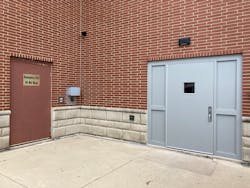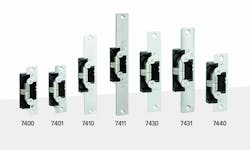Preload: Electric Strikes Under Pressure
You’re called to install an electric strike on a door, and you perform a textbook installation. Three months later, you get a call from the property manager: They’re getting complaints of the door not opening when the request-to-exit button is hit.
The most likely culprit: preload. If you’ve installed enough electric strikes, chances are you’ve dealt with the ramifications of preload at some point.
Preload is a condition whereby enough pressure builds up on a door that it causes binding between the latch and the electric strike keeper. This binding could cause the door to fail to open electrically, unless the user pushes and pulls on the door to reduce the pressure.
Larry Schwalb, security engineer at Houdini Lock & Safe in Philadelphia, likens the binding that can occur to grasping a finger with one hand.
“If you do that, you’ll notice that you can’t turn your finger in your tight fist, but if you loosen your fist up, then you can rotate your finger,” he notes. “Well, the same thing can happen when you’re dealing with preload. The electric strike and a latch are similar to if you install a doorknob and a spindle. If you don’t leave a little bit of play for the spindle that’s attached to the knob when you’re centering them up, then the knob and spindle can’t turn freely. It binds up.”
If this happens frequently enough, it can cause headaches for building managers having to deal with constant complaints, which then can be turned on the security pros who installed the strike. A bad user experience can lead to changes in products — and installers.
A few manufacturers make electric strikes that operate under preload conditions. These strikes typically cost more than similar-size standard strikes, which is why not every strike is made to handle preload.
It’s important to be aware of how and where preload can cause problems and what security pros can do to alleviate such problems.
The Heat Is On
Unfortunately, the biggest problem in dealing with preload is that “the lock professional doesn’t always have a means to relieve the pressure,” Schwalb says. That’s because preload often involves factors that are beyond the control of a security pro.
For example, you certainly can’t control the climate.
Rodger Schmidt is a technical product trainer for ASSA ABLOY. Before that, he worked as a security pro in Arizona who had to deal with electric strikes failing because of preload.
“The first time I got burned by preload, I did a 14-building complex” he says. The installation was performed between October and March, and even though everything passed inspection and worked perfectly, by June, Schmidt started hearing the complaints. “I started getting phone calls from the property manager, who said, ‘Hey, we have an issue here: I have seven doors that every afternoon I have the exact same problem with — I have push-pull pressure.’”
The problem, of course, is that during the summer, temperatures on an exterior west-facing door might reach 190 degrees Fahrenheit, Schmidt says. That will cause the door to swell and an electric strike to bind because of the pressure. Schmidt hadn’t accounted for the temperature difference, so he ultimately had to replace the strikes on those seven doors with preload strikes.
“It’s a lesson learned that I never forgot,” he says.
Airing Out Grievances
Extreme heat isn’t the only climate consideration when it comes to preload. Extreme humidity, such as what occurs in Florida and other tropical regions, also can cause problems, Schmidt says. However, the most common climate condition that can cause preload and affect strike performance is man-made.
“The No. 1 factor that creates preload is HVAC systems; they call that stack pressure,” Schwalb says. An air-conditioning system that doesn’t include an air exchanger can create a lot of pressure buildup, particularly if the exterior doors have thick weatherstripping. “The bigger the building, the more that stacked pressure can occur.”
Preload from external and internal climate conditions most typically affects exterior doors. But that doesn’t mean that security pros don’t have to consider preload buildup on interior doors.
Electric strikes on interior doors can be affected by preload that’s caused by problems with the door itself. If a door warps and falls out of alignment, that can lead to preload and binding. The same is true of poorly installed door hardware. (This, of course, also can be a problem with exterior doors.)
Schmidt notes a scenario where to counteract preload pressure on an internal door, a preload strike was installed. However, this wasn’t an adequate solution because of the poor condition of the door.
“What they should have done was replace the door,” he says. The strike was unlikely to resolve the situation, “because that door was already warped significantly, and we have preload pressure against it already.”
What Can You Do?
The first order of business when encountering preload, as it is with the installation of any locking solution, is to inspect the door. A warped or misaligned door can be identified quickly and remedied — and should be before any new equipment is added to the door.
A couple of adjustments also can be made in the field to alleviate preload pressure. Steve Norch, owner of Bierly-Litman Lock & Door of Canton, Ohio, says he might adjust the strike itself “to allow yourself a little bit more play, so it isn’t putting pressure on that latch plate.”
Matt Branson, product manager for electric strikes at ASSA ABLOY, says many models of electric strike by multiple manufacturers allow for that adjustability.
“Original strikes, when they first came out, they were very static,” he explains. “They mounted up in the ANSI 4-7/8 prep and you couldn’t move them. Now, we’ve created some integrated adjustability to allow for kind of a horizontal-axis shift that allows you to shift a strike forward and backward. So, you can alleviate the preload condition.”
Another potential adjustment is to the door closer. Most doors that have an electric strike will have a door closer as well, and tweaking the closer speed depending on the conditions (heavier in the winter, slower in the summer) can help to alleviate stack pressure caused by an HVAC system.
However, Schwalb warns that because of air “dumping,” in the summer, a door closer that’s adjusted incorrectly could cause an out-swinging door to slam, which could create a safety hazard and damage the door.
Another adjustment, thinning out weatherstripping around a door, also could be problematic, because although it relieves the pressure caused by air trying to escape, it also could cause a building to fall out of code if it’s in a jurisdiction bound by energy codes.
“There’s a lot of pieces to the puzzle,” Schwalb says.
The Right Strike
ASSA ABLOY brands Adams Rite and HES, as well as Camden Door Controls and Trine Access Technology, offer electric strikes that account for preload and will open with up to a certain amount of preload pressure on the door.
However, David Price, vice president of communications and corporate development at Camden, clarifies that the amount of preload is what separates so-called preload strikes from standard strikes that can handle preload.
“Some strikes, because of their design, can withstand a fair amount of preload, even though they’re not called preload strikes,” he says. “They can stand 5 pounds of preload pressure or 3 pounds of preload pressure and still operate flawlessly. The ones that installers have the least amount of trouble with are the strikes that probably have the highest resistance to preload pressure.”
Depending on the manufacturer, preload strikes can handle up to 25 pounds of preload pressure and still release on command. Schmidt says that should account for most situations where preload can be a problem.
“For the most part, 15–20 pounds is about the max you’ll run into in the field, unless you have something really bad,” he says.
The difference is in the strike’s design. As mentioned, some strikes allow for more adjustability, which enables them to overcome preload. The top preload strikes, however, have “cams” or “lever arms” that open and a release function that allows the latch to be released under high preload pressure.
These extra mechanisms don’t affect installation — the installation of a preload strike is no different from any other strike. However, they can add a significant premium to the price of an electric strike, so it’s important to educate customers about preload, how it can be a problem and the possible solutions that exist.
During a site survey, in addition to checking on the door itself, Schmidt says he’ll check on the condition of the people who will use the door by asking the following question to the property manager or maintenance person: “Do you have a bunch of people who are complainers about everything that’s wrong?”
The answer could lead him to suggest a preload strike at the outset despite the higher price, because the price differential could make the difference between “an electric strike that will work vs. something that’s going to create a nightmare in complaints every single day.”
Schwalb agrees, adding that the preload mechanisms make the strikes less aesthetically pleasing than standard strikes, “but when they work, that’s all that matters,” he says.
Will Christensen | Senior Editor
Will Christensen is senior editor at Locksmith Ledger International. He has been an editor and reporter at magazines and newspapers for more than 30 years.








